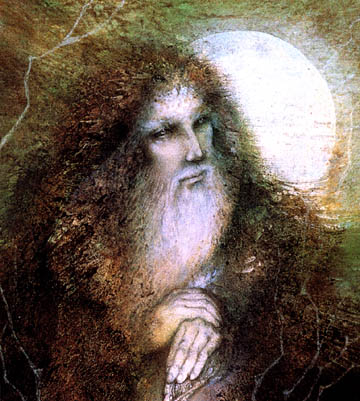
"Deer in the Moonlight" Lithograph 1859 by William Morris Hunt
Super Solstice!
by Linda Pascatore
(C) 1999 The Gobbler Winter Crystal

"Deer in the Moonlight" Lithograph 1859 by William Morris Hunt
Super Solstice!
by Linda Pascatore
(C) 1999 The Gobbler Winter Crystal
This year, we will witness a rare and significant sky event on the solstice. On December 22nd the winter solstice, a full moon, and a lunar perigee will occur simultaneously. It is as if someone up there planned this super sky show as a gift to ring in the new millennium. The moon will be brighter and appear larger than usual. This combination of solar and lunar occurrences hasn't happened for the past 133 years.The winter solstice is already one of four annual solar events. It is the shortest day and the longest night of the year. From this point on the days will grow longer and the nights shorter. At the spring equinox they will be of equal length, and at the summer solstice we will experience the opposite, the longest day and shortest night. As the earth makes it's annual revolution around the sun, the axis is tilted at a constant angle. The north pole always points at the north star. At winter solstice, we are at a point in the revolution where, here in the northern hemisphere, the tilt is at the greatest angle away from the sun. From the solstice on, we will begin to tilt towards the sun again, bringing more light. Even though the angle is tilted away from the sun at winter solstice, the earth is actually closest to the sun at this time. That means that the sunlight striking the moon is 7% stronger, making the moon appear that much brighter.
The full moon, of course, occurs every month when the moon in its rotation is at a point where the earth is lined up directly between the moon and the sun. So from the earth, the moon and sun are in opposite positions. The sun sets in the west at the same time as the moon rises in the east. Since the two are lined up, the moon gets full sun shining on it at night, and we see a full moon. On the other hand, at new moon the moon rises at sunrise, and it is directly between the earth and the sun, so with no sunlight shining on the side which faces us, the moon is not visible from the earth. Of course at half moon it is at a right angle between the earth and the sun, and rises at either noon or midnight depending on whether it is waxing or waning.
The lunar perigee is the closest approach of the moon to the earth. The moon has an elliptical orbit, and at perigee it is the closest to the earth and at apogee it is the farthest away. At perigee, the moon appears about 14% larger than at apogee. Since this year the lunar perigee is on the solstice, the moon will appear both larger and brighter. The last time this combination occurred was on December 21, 1866.
If the weather is clear on December 22nd, and especially if there is snow on the ground where you live, it will be an extremely bright night. Some experts believe that car headlights will be superfluous that night, although we certainly don't recommend you drive without them. However, we do encourage you to take advantage of this once in a lifetime astronomical event, and spend some time outdoors enjoying the longest night accompanied by the brightest moonlight. Most of the religious holidays at this time of year, including Christmas and Hanukah, had their origins in solstice celebrations. So, why not begin a new tradition of connecting with nature and the heavenly bodies and marking the solstice with family or friends?
Editor's Note: We will be attending a special sweat lodge ceremony marking the occasion, and if you check The Gobbler after the solstice, there will be an article on how we celebrated.